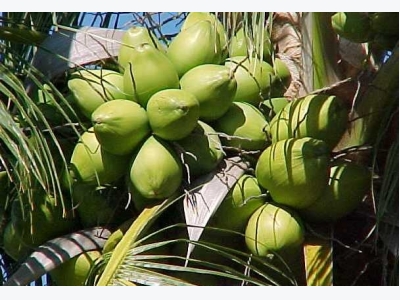Coconut Farming Information Guide

Introduction of Coconut Farming:- Coconut plays very significant role in Asian economy and grown throughout tropical world. Dried coconut kernels (copra) and coconut oil is widely used in soap manufacturing, cosmetics and hair oils. Coconuts also used in many industrial products, which husk is source of fibre used in coir industry. The tender coconut water is a popular thirst quencher of health and virgin coconut oil (VCO), extracted from fresh coconut kernel without any chemical processes is full of vitamins, minerals and anti-oxidants, thus making the coconut oils as “mother of all oils”. In India, commercial cultivation of coconut is major contributor of rural economy; these nuts are cultivated not only in coastal area but also in other states. With good farm management practices farmers can achieve maximum yield and thus profits. Coconut is cultivated in more than 93 countries of the world and Indonesia, Philippines, India are the major production countries in the world. In India, Kerala, Karnataka, TamilNadu, Telangana, Andhra Pradesh, Orissa, Goa, West Bengal, Pondicherry, Maharashtra and Islands of Lakshadweep and Andaman and Nicobar, Gujarat, Assam, Madhya Pradesh, Bihar, Tripura, Manipur, Arunachal Pradesh and Nagaland are major commercial production and traditional cultivated states. Coconut belongs to the family of “Arecaceae” (Palm family) and genus of “Cocos”.

Coconut Farming
Health Benefits of Coconut:- The following are some of the health benefits of coconut.
- Coconut helps in preventing obesity.
- Coconut is a high source of dietary fiber.
- Coconut helps in improving heart health.
- Coconut has a low glycemic index (GI), which is good for diabetic patients.
- Coconut reduces sweet cravings.
- Coconut helps in improving digestion
- Coconut water is a quick energy booster.
- Coconut improves immune system.
Other uses of Coconut: Tender coconut water is good for health; coconut milk is used in many food preparations

Health Benefits of Coconut
Coconut Production Countries in Asia:- India, Indonesia and Philippines are major producers of the coconut in the world.
Local Names of Coconut in Asia:- Kalpa Vriksha (Sanskrit),Naariyal/Nariyal (Hindi), Kobbari Kaaya (Telugu), Thengai (Tamil),Thengina Kai (Kannada),Thenga (Malayalam), Nariale (Gujarati), Narala (Marathi), Naarl (Konkani), Nariar (Bhojpuri), Nadia (Oriya), Narikela (Bengali), Khoprah (Kashmiri), Kelapa (Malay), Narikol (Assamese), Kokoyaja (Korean), Ma phra (Thai), Nariyal (Urdu), Nariwal (Nepali), Pol (Sinhalese), Ng Niyog (Filipino), Dua (Vietnamese), Kokoyashi (Japanese), Yezi (Chinese), Oun (Burmese), Jooz al-hind (Arabic), Hindistan cevizi (Turkish), Kokos (Russian).
Varieties/Hybrids of Coconuts:- There are many commercial hybrid varieties of coconut available. The tall varieties are extensively grown most part of India other part of Asia while dwarf variety is grown mainly for parent material in hybrid seed production & for tender coconuts. Tall varieties: Benaulim, Laccadive Ordinary, Laccadive Micro, Tiptur,Tall, Kappadam, Komadan & Andaman Ordinary.
Dwarf varieties: Chowghat Dwarf Orange, Chowghat Dwarf Yellow, Chowghat Dwarf Green, Malayan Yellow Dwarf & Malayan Orange Dwarf.
Water Variety: Bangalore Bondam, Ganga Bondam.
Climate Required for Coconut Farming:- Basically, coconut palm is a tropical fruit plant, however it has been grown under various climatic conditions. This crop requires annual temperature of 27°C for optimum growth and maximum yield of coconut. The coconut tree can be grown up to an altitude of 700 meter above mean sea level (msl).Coconut crop requires evenly distributed rainfall ranging from 1500 mm to 3000 mm for proper growth and higher production.
Soil Requirement for Coconut Farming:- The coconut can be grown on wide variety of soils. However, red sandy loam, alluvial, laterite and coastal sandy well-drained soils rich in organic matter and with a pH ranging from 5.0 to 8.0 are best for its growth and higher yield.
Selection of Site for Coconut Farming:- Site selection plays a major role in producing coconuts. Soil with a minimum depth of 1.2 to 1.5 meter and good water holding capacity should be selected for coconut cultivation. Soils with underlying hard rock or soils with water logging and poor drainage should be avoided. Clayey soils are not suitable for coconut production.
Land Preparation, Spacing and Plantation in Coconut Farming:- First and foremost, in any farming, size of the pit depends on the soil type and water table of the soil. In loamy soils, pits with size of 1 x 1 x 1 meter should be dug and filled with top soil to the height of 40 to 50 cm. In laterite soils, large pits are recommended and pits size of 1.2 x 1.2 x 1.2 meter should be dug and filled with loose soil, well rotten farm yard manure like cow dung and ash up to a depth of 55 to 60 cm before planting. For moistureconservation, 2 layers of coconut husk should be placed at the bottom of the pit with concave surface facing upwards while filling the pits. For prevention of termite attack, BHC 10 % DP should be sprinkled on the coconut husk. In-order to soften the hard pan of the soil, common salt of 2 kg per pit should be applied at least 6 months before the plantation. Generally, a square system of planting is preferred with a spacing of 7.5 x 7.5 meter which will accommodate 178 coconut-palms per 1 hectare. However, a spacing of 7.0 to 10 meter is practiced in many coconut growing regions of the country. Selection of quality seedlings is very important for better yield. Farmers should select vigorous coconut seedlings of 1 year old and having minimum of 10 cm at the collar level to plant in the farm land. Early splitting of leaves in the seedlings could be a factor of selecting good seedlings. In case of water logged areas, 18 months to 24 months old seedlings are preferred. The best planting season in coconut farming is May to June which is pre-monsoon time frame.
Propagation in Coconut Farming:- Propagation is done through seeds. Seedlings can be raised on nursery beds and transplanted in the main field.

Coconut Seedlings
Manures and Fertilizers in Coconut Farming:- The regular manuring and chemical fertilizers should be carried from the first year of plantation for proper vegetative growth, early flowering and fruit bearing. The first application of in-organic fertilizers should be carried after 3 months of coconut plantation. In case of lateritic and acidic soils, Rock phosphate is recommended as source of phosphorus. Usually fertilizers should be applied in 2 split doses during May to June and Sep to Oct months for rainfed trees. In case of irrigated palms, 4 or more equal split doses should be carried to avoid heavy rainfall period. In case of sandy soil with acidic nature, 1 kg of dolomite should be supplemented during April to May in the plant basins and should be forced into the soil. This application is in addition to regular fertilizers.
The following chart shows the manure/fertilizers requirement in coconut farming
| Fertilizers/Manures | 1st Year | 2nd year | 3rd year |
| FYM (kg/palm) | 40 to 45 | 20 to 25 | 25 to 30 |
| N (grams/palm) | 50 | 160 | 330 |
| P (grams/palm) | 40 | 120 | 240 |
| K (grams/palm) | 135 | 400 | 810 |
Irrigation in Coconut Farming:- Coconut palms require 200 to 250 liters of water once in 4 days under basin irrigation conditions where as in summer, 40 to 45 liters of water/palm/week will increase the yield. In case of water problem, one should go for drip irrigation. The quantity of water recommended for drip irrigation is 66 % of the open pan evaporation. However, irrigating the palms depends on the soil type and climatic conditions.
Intercultural Operations in Coconut Farming:- As part of inter-cultural operations, ploughing, digging and forming small mounds during the months of Aug-Sept and spreading them in the months of Dec to Jan should be carried out. Other beneficial operations are, making shallow basins with a radius of 2 meter before the onset of monsoon and filling them at the close of monsoon. In order to control the weeds, regular inter-cultural operations are advised. Mulching can be done at tree basins with dry hay to retain the moisture, control the weed growth and protect the soil from erosion. pre-emergence spraying of atrazine @ 1.0 kg a.i./ ha will control the broad-leaved weeds where as Post emergence spraying of glyphosate @ 10 ml and 20 grams ammonium sulphate / litre of water will control the grasses and sedges.
Inter-cropping in Coconut Farming:- Farmers can utilize the inter-space in the coconut palm orchard by cultivating crops like banana, ground nut (peanut),elephant foot yam, pineapple, sweet potato, chillies or any other vegetable and legume crops during initial 6 to 8 years period. In older plantation of coconut, cinnamon, cocoa, pepper and clove can be cultivated as mixed crops along with inter-crops. Mixed farming by growing fodder grasses such as guinea grass or hybrid napier found very and also supports the animal feed requirements.
Pruning in Coconut Farming:– Pruning activities like removing dried leaves or dead leaves or diseased leaves should be carried out regularly. Regular cleaning of the palm basins will check the weeds.
Pests and Diseases in Coconut Farming:- The following are the main pests and diseases found in coconut farming.
Major insect-pests found in coconut farming are: Mealy bugs and Scale insects, Termites, White grub, Eriophid Mite of Coconut, Slug Caterpillar, Rhinoceros Beetle, Red Palm Weevil, Black headed caterpillar, Coreid bug and Rats.
Major diseases found in coconut farming are: Bud rot, Leaf rot, Stem Bleeding, Root (wilt) disease, Tanjavur wilt, Mahali, Crown chocking, Leaf blight or Grey Leaf Spot, Tatipaka Disease.
Note: For symptoms and their control measures of these pests and diseases in coconut farming, contact nearest or local Horticulture/Agriculture department.
Harvesting in Coconut Farming:- Generally, coconut palms will be ready for harvesting in about 1 year after the opening of the spathe. Coconuts are harvested at different intervals based on the need. Usually coconuts are harvested at tender stage for coconut water purpose. The frequency of harvesting also depends on the yield of the palms. In well maintained orchards, coconut bunches are produced regularly and harvesting can be done once in a month. Coconut palms can yield up to 60 years and whose economic life is about 60 to 65 years.
Yield in Coconut Farming:- Generally yield of any crop depends on the cultivar (variety) and soil type, climatic conditions, irrigation facility and farm management practices.
| S.No | Variety | Nut yield (Nos / tree / year) |
| 1 | Hybrid | 100 |
| 2 | Tall | 60 to 80 |
| 3 | Dwarf (tender coconut) | 70 to 90 |
Related news
Tools

Phối trộn thức ăn chăn nuôi

Pha dung dịch thủy canh

Định mức cho tôm ăn

Phối trộn phân bón NPK

Xác định tỷ lệ tôm sống

Chuyển đổi đơn vị phân bón

Xác định công suất sục khí

Chuyển đổi đơn vị tôm

Tính diện tích nhà kính

Tính thể tích ao



 Rice Farming Information Guide
Rice Farming Information Guide  Rose Flower Growing Tips and Trick
Rose Flower Growing Tips and Trick